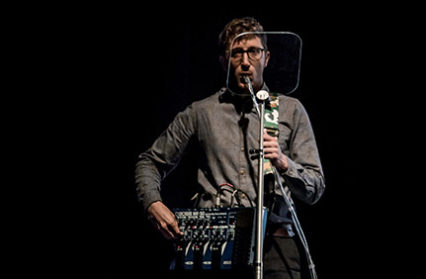Reardon Smith Theatre, Cardiff
Away from its headline acts and crowd-pleasers, Cardiff’s inaugural Festival of Voice is vying to do something much more interesting than just throw a party. It is, in essence, still struggling to get a handle on that all-important “festival atmosphere”, but if in future years this can be sorted then this can really become a festival of note. It is Artes Mundi who have brought to the National Museum’s gorgeous Reardon Smith theatre, Lebanese artist Lawrence Abu Hamdan to deliver his twisting and tricky essay on truth in sound. It is political, meta-critical, personal, and simultaneously playful and dry, but Hamdan keeps it short and sweet, at just over 35 minutes, and once over there is much to consider.
At first Hamdan, introducing the audience to the technology he is both holding and strapped to, as well as the software he is using, comes across as preppy. He could not be using the software he has with him tonight if it wasn’t for an Israeli tech firm making use of some coding that came out with Edward Snowden’s NSA leaks. And it must be said there is something about Snowden of Hamdan himself, slender and bespectacled, all TED talk and knowingness.
Hamdan will explore, through middle-Eastern politics and delving into the nuances of obscure Islamic sects, the nature of communication, of the politics of listening as well as speaking, and how this technology that is promising to finally do for AI what larynx have done for mammals could change the potential for human diversity. Non-communication too is very much on the cards, and how, in the Druze communities of northern Syria, for example, non-action is very much a powerful and deeply-seated form of action.
So, the future is bleak if interesting. Hamdan’s research has taken him around the world, but more fundamentally it has taken him deep into the roots of the cultures that surround his homeland. But, fundamentally, this is all a bit of rouse, isn’t it? The performance starts out with much promise, but turns out to be a few tricks with a 303 and a few sound files on his macbook projected onto the back screen. Hamdan himself is hardly an electric stage presence – but this is irony, surely? It is only halfway through the essay that it becomes apparent much of what Hamdan is saying might be fiction. Truth and untruth are bedfellows of communication and uncommunication, but which way around do they sleep? His story about finding an unidentifiable academic’s research notes recorded onto minicasette tape strewn around the branches of the trees on the outskirts of a Druze community (used to keep birds away, apparently; those great sonic communicators), is too cutesy, and perhaps a good editor may have put some rougher edges on it. But regardless, from that point on more begins to unravel, and truth and fiction overlap and merge. From this point anything is up for grabs. Is it true about the software? Is it true the Israeli tech firm is developing it? Is there such an Israeli tech firm? If the technology to twist any voice to any global accent in miliseconds with the flick of a switch is possible, then Hamdan does not display it on stage.
Of course, we can all leave the theatre and Google these things. But like so much conceptual art it is the questions that resonate and not the answers. As says Adam Driver’s awful hipster in While We’re Young, it’s better just not to know.
Festival of Voice is now over halfway done, and its textures are becoming clearer. ‘City-wide’ is an easier concept to coin than it is to sell, and bringing in all these excellent venues to partnerships is no doubt essential for the support of government bodies, but whereas these might be issues with how thin the acts of Festival of Voice are spread what is emerging is a programme of real depth where blockbuster acts and conceptual artists share a conversation.



 Enjoyed this article? Support our writers directly by buying them a coffee and clicking this link.
Enjoyed this article? Support our writers directly by buying them a coffee and clicking this link.








